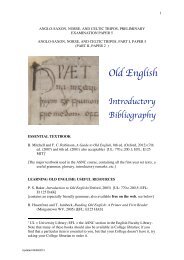Scandinavian history in the Viking age - Department of Anglo-Saxon ...
Scandinavian history in the Viking age - Department of Anglo-Saxon ...
Scandinavian history in the Viking age - Department of Anglo-Saxon ...
Create successful ePaper yourself
Turn your PDF publications into a flip-book with our unique Google optimized e-Paper software.
<strong>Scand<strong>in</strong>avian</strong> History <strong>in</strong> <strong>the</strong> Vik<strong>in</strong>g Age<br />
Gotlandic picture stones<br />
[M180] S. L<strong>in</strong>dqvist, (ed.), Gotlands Bildste<strong>in</strong>e, KVHAA arkeologiska monografier 28, 2 vols (1941-42)<br />
[UL S592:01.a.4.35-36]<br />
[M181] E. Nylén and J.P. Lamm, Stones, ships and symbols: <strong>the</strong> picture stones <strong>of</strong> Gotland from <strong>the</strong><br />
Vik<strong>in</strong>g <strong>age</strong> and before (1988) [UL 596:3.c.95.9]<br />
[M182] M. Srigley, ‘The dream <strong>of</strong> Troy: an <strong>in</strong>terpretation <strong>of</strong> <strong>the</strong> Gotland picture-stones <strong>of</strong> <strong>the</strong> late<br />
Vendel and Vik<strong>in</strong>g periods, I-II’, Tor 22 (1988-89), 161-87 and 26 (1994), 93-105<br />
[M183] A. Andrén, ‘Doors to o<strong>the</strong>r worlds: <strong>Scand<strong>in</strong>avian</strong> death rituals <strong>in</strong> Gotlandic perspectives’, JEA<br />
1:1 (1993), 33-56<br />
[M184] D. Ellmers, ‘Valhalla and <strong>the</strong> Gotland stones’, (M349):165-71<br />
Iconography<br />
The question <strong>of</strong> <strong>the</strong> symbolism <strong>of</strong> much <strong>Scand<strong>in</strong>avian</strong> art, particularly dur<strong>in</strong>g <strong>the</strong> early Vik<strong>in</strong>g <strong>age</strong>, is a<br />
difficult one; animal art <strong>in</strong> particular is tricky to p<strong>in</strong> down, and <strong>of</strong>ten seems like little more than arbitrary<br />
decoration to fill <strong>in</strong> <strong>the</strong> abhorred blank space. The Gotlandic picture stones (M180 ff.) are a treasure trove<br />
for <strong>the</strong> ambitious art-historian <strong>in</strong> this respect. For o<strong>the</strong>r pre-Christian iconographical features, see:<br />
[M190] W. Holmqvist, ‘The danc<strong>in</strong>g gods’, AA 31 (1960), 101-27<br />
[M191] P. Gjærder, ‘The beard as an iconographical feature <strong>in</strong> <strong>the</strong> Vik<strong>in</strong>g period and <strong>the</strong> early middle<br />
<strong>age</strong>s’, AA 35 (1964), 95-114<br />
On early Christian iconography, see (D60 ff.) for Jell<strong>in</strong>g, for studies <strong>of</strong> runestones (M170 ff.), and:<br />
[M195] E. C<strong>in</strong>thio, ‘“Majestas Dom<strong>in</strong>i crucifixi”’, MLUHM 1958, 193-218<br />
[M196] S. Horn Fuglesang, ‘Crucifixion iconography <strong>in</strong> Vik<strong>in</strong>g Scand<strong>in</strong>avia’, (A47):73-94<br />
[M197] M. Bl<strong>in</strong>dheim, ‘Byzant<strong>in</strong>e <strong>in</strong>fluence on <strong>Scand<strong>in</strong>avian</strong> pictorial art <strong>in</strong> <strong>the</strong> 11th and 12th centuries’,<br />
(J55):299-313<br />
Crafts and technology<br />
Archaeological research <strong>in</strong>to tools, crafts, and manufactur<strong>in</strong>g is so vast and specialised a field that only a<br />
limited selection is <strong>in</strong>cluded here; for all aspects <strong>of</strong> <strong>the</strong> field, <strong>the</strong> <strong>in</strong>troductory reader is referred to <strong>the</strong><br />
handbooks <strong>in</strong> (A), while much useful material is also to be found scattered throughout items on<br />
excavations <strong>of</strong> rural (M25 ff.) and urban (N160 ff.) sites. For <strong>in</strong>dividual aspects <strong>the</strong> articles <strong>in</strong> KLNM<br />
(A70) rema<strong>in</strong> <strong>in</strong>valuable guides, even if <strong>the</strong>y have sometimes been superseded by more recent<br />
discoveries.<br />
[M200] For older general surveys, see <strong>the</strong> ‘Nordisk kultur’ series [UL 592:01.b.1.1 ff.], <strong>in</strong> particular: [a]<br />
14: Från trä till stål, ed. S. Erixon (1953); [b] 15: Lergods, ädelmetaller och vävnader, ed. S. Erixon<br />
(1953). Also useful are <strong>the</strong> items on weaponry and dress: [c] 12:B: Vapen, ed. B. Thordeman (1943); [d]<br />
15:B: Dragt, ed. P. Nørlund (1941)<br />
[M201] D.M. Wilson and M.L. Caygill, (edd.), Economic aspects <strong>of</strong> <strong>the</strong> Vik<strong>in</strong>g <strong>age</strong>, British Museum<br />
occasional paper 30 (1981) [UL OP.1100.70.07(30)]<br />
Tools<br />
[M205] J. Petersen, Vik<strong>in</strong>getidens redskaper, SDNVAO 1951:4 [UL 500:01.b.4.67] (E.s.); <strong>the</strong> standard<br />
catalogue<br />
[M206] G. Arwidsson and G. Berg, The Mästermyr f<strong>in</strong>d: a Vik<strong>in</strong>g <strong>age</strong> tool chest from Gotland (1983)<br />
[UL S592.b.98.22]<br />
Weaponry<br />
For important surveys <strong>of</strong> swords found <strong>in</strong> <strong>the</strong> East, see (J40 ff.); for Scand<strong>in</strong>avia, also (M200c). Most<br />
excavation reports <strong>of</strong> rich burials <strong>in</strong> particular will <strong>in</strong>clude comments on weaponry found with<strong>in</strong>; for<br />
more general surveys:<br />
[M210] H. Falk, Altnordische Waffenkunde, SDNVAO 1914:6 [UL 500:01.b.4.18]<br />
[M211] J. Petersen, De norske vik<strong>in</strong>gesverd: en typologisk-kronologisk studie over vik<strong>in</strong>getidens vaaben,<br />
SDNVAO 1919:2 [UL 500:01.b.4.23]; rema<strong>in</strong>s <strong>the</strong> classic survey <strong>of</strong> swords and <strong>the</strong>ir chronology<br />
128






